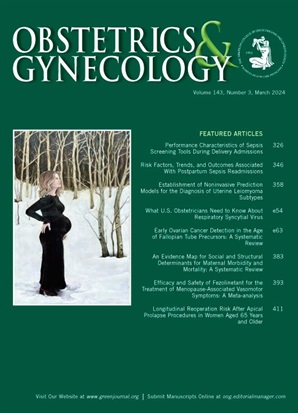博茨瓦纳人类免疫缺陷病毒(HIV)感染者使用抗逆转录病毒治疗的不良产妇结局
IF 4.7
2区 医学
Q1 OBSTETRICS & GYNECOLOGY
引用次数: 0
摘要
目的:本研究旨在评估博茨瓦纳人类免疫缺陷病毒(HIV)感染率高的大型队列在实施“全治疗”政策后的产妇结局。方法回顾性队列研究收集患者2021年11月至2023年12月出院时的病历资料。结果记录在博茨瓦纳Marina公主医院的Tsepamo分娩结果监测和安全分娩研究中。我们通过HIV感染状况评估产妇死亡率和产科发病率,包括子痫前期、子痫、出血、感染和出院时的急性肺部或心脏疾病。结果纳入11754名受试者;2201例(18.7%)为艾滋病毒感染孕妇。97%(2135人)在分娩时接受抗逆转录病毒治疗(ART);1996名(93.5%)已知抗逆转录病毒治疗方案的患者服用了多替格雷韦、富马酸替诺福韦二吡酯和拉米夫定。在已知CD4计数的1090名HIV感染者中,757人(69.4%)超过500个细胞/微升,只有42人(3.9%)低于200个细胞/微升。在已知病毒载量的1524名艾滋病毒感染者中,1436名(94.2%)在初始检测中未被检测到。出血(90 [4.1%]vs 370[3.9%],校正风险比[RR] 0.93, 95% CI, 0.73-1.17)、感染(38 [1.7%]vs 126[1.3%],校正风险比[RR] 1.56, 95% CI, 0.97-2.51)、子痫(6 [0.3%]vs 28[0.3%],校正风险比1.12,95% CI, 0.50-2.53)、急性肺部或心脏疾病(15 [0.7%]vs 43[0.4%],校正风险比1.22,95% CI, 0.65-2.27)、输注2个或更多单位的红细胞(33 [36.7%]vs 110 [29.8%], P= 0.21)、额外子宫强张(48例[53.3%]vs 173例[47.1%],P= 0.29),氨甲环酸使用(31例[34.4%]vs 106例[29.0%],P= 0.31),重症监护病房入院(4例[0.2%]vs 10例[0.1%],P= 0.31),机械通气(3例[0.1%]vs 6例[0.1%],P= 0.38),加压剂支持(2例[0.1%]vs 2例[0.0%],P= 0.16),或死亡率(5例[0.2%]vs 11例[0.1%],校正RR 1.44, 95% CI, 0.46-4.57)。有一些显著差异,包括先兆子痫的风险略有降低(184 [8.4%]vs 818[8.6%],调整RR 0.84, 95% CI, 0.71-0.98),尽管罕见,但与未感染HIV的人相比,子宫破裂的风险增加(12 [0.5%]vs 8[0.1%],调整RR 6.54, 95% CI, 2.33-18.33)。结论:在整合酶链抑制剂(主要是多替格拉韦)全面治疗的时代,艾滋病毒感染者和非艾滋病毒感染者的不良产科结局差异不大;值得注意的例外包括先兆子痫的风险略有降低,尽管罕见,但感染艾滋病毒的人子宫破裂的风险增加。本文章由计算机程序翻译,如有差异,请以英文原文为准。
Adverse Maternal Outcomes Among People With Human Immunodeficiency Virus (HIV) Using Antiretroviral Therapy in Botswana.
OBJECTIVE
This study aimed to evaluate maternal outcomes in a large cohort with high prevalence of human immunodeficiency virus (HIV) infection in Botswana after implementation of a treat-all policy.
METHODS
In this retrospective cohort study, data were collected from the medical record at the time of discharge from November 2021 to December 2023. Outcomes were recorded in the Tsepamo Birth Outcomes Surveillance and Safe Birth studies at Princess Marina Hospital in Botswana. We evaluated maternal mortality and obstetric morbidities by HIV status, including preeclampsia, eclampsia, hemorrhage, infection, and acute pulmonary or cardiac conditions at the time of hospital discharge.
RESULTS
We included 11,754 participants; 2,201 (18.7%) were pregnant people with HIV infection. Ninety-seven percent (2,135) were on antiretroviral therapy (ART) at time of delivery; 1,996 (93.5%) of those with a known ART regimen were on dolutegravir, tenofovir disoproxil fumarate, and lamivudine. Of the 1,090 people with HIV infection with known CD4 counts, 757 (69.4%) had more than 500 cells/microliter, and only 42 (3.9%) had fewer than 200 cells/microliter. Of 1,524 people with HIV infection with known viral loads, 1,436 (94.2%) were undetectable on initial testing. There were no statistically significant differences in incidence of hemorrhage (90 [4.1%] vs 370 [3.9%], adjusted risk ratio [RR] 0.93, 95% CI, 0.73-1.17), infection (38 [1.7%] vs 126 [1.3%], adjusted RR 1.56, 95% CI, 0.97-2.51), eclampsia (6 [0.3%] vs 28 [0.3%], adjusted RR 1.12, 95% CI, 0.50-2.53), acute pulmonary or cardiac conditions (15 [0.7%] vs 43 [0.4%], adjusted RR 1.22, 95% CI, 0.65-2.27), transfusion of 2 or more units of packed red blood cells (33 [36.7%] vs 110 [29.8%], P=.21), additional uterotonics (48 [53.3%] vs 173 [47.1%], P=.29), use of tranexamic acid (31 [ 34.4%] vs 106 [29.0%], P=.31), intensive care unit admission (4 [0.2%] vs 10 [0.1%], P=.31), mechanical ventilation (3 [0.1%] vs 6 [0.1%], P=.38), pressor support (2 [0.1%] vs 2 [0.0%], P=.16), or mortality (5 [0.2%] vs 11 [0.1%], adjusted RR 1.44, 95% CI, 0.46-4.57) in people with HIV infection compared with those without HIV infection. There were few notable differences, including a slightly reduced risk of preeclampsia (184 [8.4%] vs 818 [8.6%], adjusted RR 0.84, 95% CI, 0.71-0.98) and, although rare, an increased risk of uterine rupture (12 [0.5%] vs 8 [0.1%], adjusted RR 6.54, 95% CI, 2.33-18.33) in people with HIV infection compared with those without HIV infection.
CONCLUSION
There was little difference in adverse maternal obstetric outcomes between people with and those without HIV infection in the treat-all era with integrase strand inhibitors (primarily dolutegravir); notable exceptions included a slightly reduced risk of preeclampsia and, although rare, an increased risk of uterine rupture in those with HIV infection.
求助全文
通过发布文献求助,成功后即可免费获取论文全文。
去求助
来源期刊

Obstetrics and gynecology
医学-妇产科学
CiteScore
11.10
自引率
4.20%
发文量
867
审稿时长
1 months
期刊介绍:
"Obstetrics & Gynecology," affectionately known as "The Green Journal," is the official publication of the American College of Obstetricians and Gynecologists (ACOG). Since its inception in 1953, the journal has been dedicated to advancing the clinical practice of obstetrics and gynecology, as well as related fields. The journal's mission is to promote excellence in these areas by publishing a diverse range of articles that cover translational and clinical topics.
"Obstetrics & Gynecology" provides a platform for the dissemination of evidence-based research, clinical guidelines, and expert opinions that are essential for the continuous improvement of women's health care. The journal's content is designed to inform and educate obstetricians, gynecologists, and other healthcare professionals, ensuring that they stay abreast of the latest developments and best practices in their field.
 求助内容:
求助内容: 应助结果提醒方式:
应助结果提醒方式:


